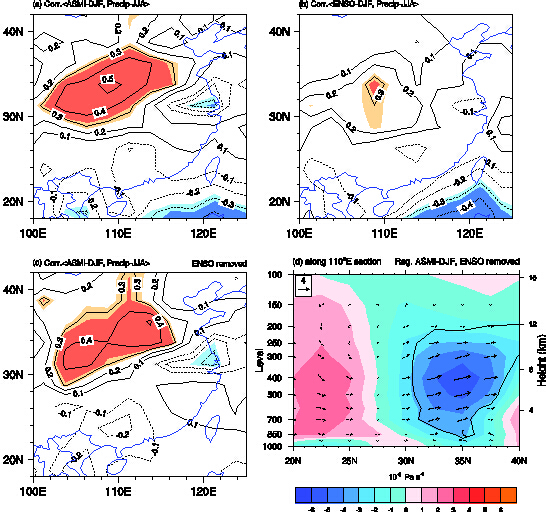新论文介绍:He, S.-P., 2015: Potential connection between the Australian summer monsoon circulation and summer precipitation over central China, Atmos.
[发布日期: 2015-05-11 浏览量 2422]
中文摘要:本文研究了澳大利亚夏季风与中国中部夏季降水的联系。结果表明,澳大利亚夏季风异常偏弱之后,东亚夏季风和西北太平洋副热带高压明显偏强,将更多的水汽向北输送到中国中部。同时,110°E附近30-37.5°N之间有明显的上升运动异常。因此,中国中部夏季降水异常偏多。进一步分析表明,在澳大利亚夏季风异常偏弱的冬季,印度洋和南海海温偏高。由于海洋的“记忆性”,冬季印度洋的暖海水可以持续到次年夏季,从而激发开尔文波进入西北太平洋,进而抑制对流发展并引发反气旋异常。此外,由于海气相互作用,南海海温的异常信号随时间逐渐向东发展,导致夏季西太平洋海温升高。通过影响对流活动,西太平洋的暖海水可以引起东亚夏季大气环流和降水的显著变化。
英文摘要:This study investigated the connection between the Australian summer monsoon (ASM) and summer precipitation over central China. It was found that, following a weaker-than-normal ASM, the East Asian summer monsoon and western North Pacific subtropical high tend to be stronger, yielding anomalous northward moisture to be transported from the western Pacific to central China. Besides, anomalous upwelling motion emerges over 30–37.5°N, along 110°E. Consequently, significant positive summer precipitation anomalies are located over central China. Further analysis indicated that the boreal winter sea surface temperature (SST) in the Indian Ocean and South China Sea shows positive anomalies in association with a weaker-than-normal ASM. The Indian Ocean warming in boreal winter could persist into the following summer because of its own long memory, emanating a baroclinic Kelvin wave into the Pacific that triggers suppressed convection and an anomalous anticyclone. Besides, the abnormal SST signal in the South China Sea develops eastward with time because of local air-sea interaction, causing summer SST warming in the western Pacific. The SST warming can further affect East Asian atmospheric circulation and precipitation through its impact on convection.
引用:He, S.-P., 2015: Potential connection between the Australian summer monsoon circulation and summer precipitation over central China, Atmos. Oceanic Sci. Lett., 8, 120–126, doi:10.3878/AOSL20140091.
链接:http://159.226.119.58/aosl/EN/volumn/current.shtml
 图1:
图1:1979-2014夏季(JJA)降水与(a)澳大利亚夏季风(DJF)指数,(b)前冬Niño3.4指数的相关系数。深、浅阴影分别表示通过95%、90%置信水平统计检验的值。(c)与(a)类似,只是去掉了ENSO的线性信号。(d)1979-2014年夏季110°E剖面垂直风场(矢量,单位:m s
-1)、垂直速率(阴影,单位:´ 10
−3 Pa s
−1)针对澳大利亚夏季风指数的线性回归系数,黑色等值线内表示垂直速率通过了90%置信水平统计检验。
Figure 1 Correlation between boreal summer (June–August, JJA) precipitation anomalies during 1979–2014 and (a) Australian summer monsoon index (ASMI) (December–February, DJF) and (b) preceding winter (DJF) Niño3.4 index. Light (blue and yellow) shading are at the 90% confidence level, and dark (blue and yellow) shading are at the 95% confidence level based on the Student’s
t-test. (c) As in (a), but with the signal of ENSO removed. (d) Vertical-horizontal cross section along 110°E for vertical wind (vectors; units: m s
−1) and omega (shading, units: ´ 10
−3 Pa s
−1) anomalies during the summers of 1979–2014 regressed onto the ASMI (signal of winter ENSO removed). Omega anomalies enclosed by thick contours are at the 90% confidence level based on the Student’s
t-test.
